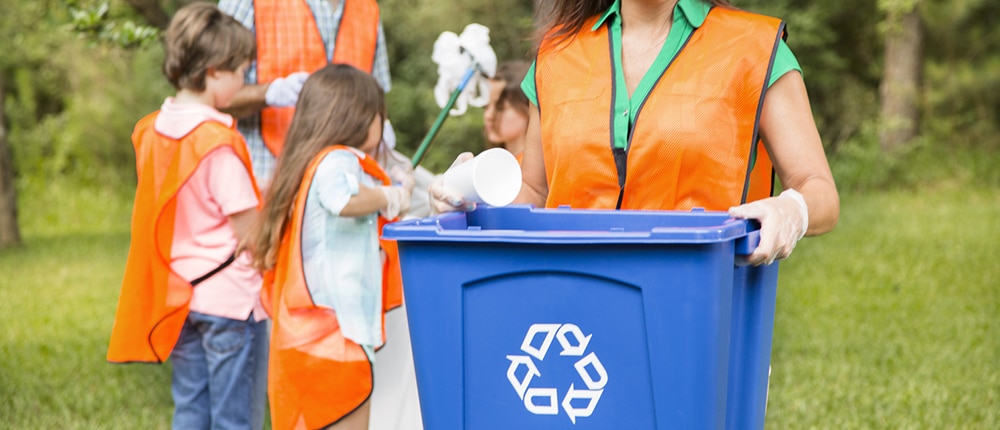The U.S. hasn’t always been that great at recycling, but we’re getting better. During WWII Americans were very conscious about waste and about 25% of it was reused or recycled. But things went the wayside soon after. During the 1960s recycling was at its lowest point at just 7.7%. In 1980, 15 million tons of waste was recycled. Fast forward to 2012 and we now recycle 87 million tons of waste, which is a whooping 34.5% of all trash.
Some people brush off recycling environmental benefits because energy is used to re-purpose recyclables. While that is true, recycling is still worth the effort since it decreases the size of our ever-growing landfills and does in fact reduce the release of carbon dioxide. Research from Stanford University determined that manufacturing recycled products requires less energy and is cleaner. At the end of the day using recycled materials is more energy efficient than using raw materials no matter whether it’s glass, paper, plastic or metal.
Although progress has been made, we can still improve the country’s recycling stats. But there’s one big hang up – many people aren’t sure what’s recyclable.
Some recyclables are obvious, like newspapers and plastic bottles. Others are more questionable. In a time when technology and expanded programs are allowing us to recycle more products it’s more important than ever for people to know what is and isn’t recyclable.
Check the Bottom
Products that are recyclable will be marked with the universal recycling symbol – a triangle made of three arrows. There will also be a number inside the triangle. The number is the resin identification code, and the number is very important because it indicates what type of recyclable it is. Some city programs are able to process every type of recyclable while others are only equipped to recycle the basics.
Guide to Recycling Numbers:
- Polyethylene Terephthalate (PET or PETE) plastic (recyclable almost everywhere)
- High Density Polyethylene (HDPE) plastic (recyclable almost everywhere)
- Vinyl (V or PVC) plastic (sometimes accepted, often taken by plastic lumber makers)
- Low Density Polyethylene (LDPE) plastic – (sometimes accepted, acceptance is increasing)
- Polypropylene (PP) plastic – (sometimes accepted, acceptance is increasing)
- Polystyrene (PS) – (not accepted most of the time)
- Miscellaneous – (acceptance varies, not accepted most of the time)
Today, a growing number of major city recycling programs accept all types of recyclables. You’ll want to look for the recycling symbol, but there’s no need to check the number.

Check the Local Policies
There are no national regulations on recycling. Each state and municipality has their own recycling programs, procedures and management laws. The capability of the local facilities also comes into play.
One of the most important policies to know is which recyclables are accepted. You’d think that any recyclable would be accepted, but that isn’t always the case. It comes down to what the local facility is equipped to process.
Another thing you’ll need to check on is whether recyclables need to be separated. Some cities require paper products to be separated from plastics and metals. This usually means you’ll need two or more recycling containers.
If your city has single stream recycling you’re in luck. A single stream recycling system doesn’t require separation. All recyclables can be collected together so you don’t have to figure out which group a recyclable belongs in. That work is done at a materials recovery facility using high-tech, optical sorter equipment and magnetic belts.
Check the Type of Metal
Since aluminum cans are a common recyclable many people mistakenly believe all metal can be put in the recycling bin. Unfortunately, this isn’t the case.
Take steel for example. Steel can certainly be re-purposed, but it can’t be processed at most city or municipality recycling centers. You’ll need to take many metal products to specialty recycling centers rather than leaving them curbside.
Keep Things Clean and Dry
Some items that are perfectly fine for recycling can be compromised to the point they have to be put in the landfill. Three of the most common occurrences are:
- Paper that becomes wet
- Glass that breaks
- Containers covered in food remnants
When you’re collecting recyclables try to keep things as clean and dry as possible so no items get sent to the dump.
Don’t Forget the Yard Trimmings
One recyclable that’s often overlooked is yard trimmings. Instead of being piled up in a landfill, yard debris can be re-purposed into mulch. However, there are limitations. Many municipalities won’t accept trimmings from palms due to safety hazards, and trimmings may need to be cut down to small pieces before recycling.
Recycling is a great way to conserve energy without putting in much effort. It’s almost as good as using a 100% renewable energy plan from Verde Energy! Check to see which renewable electricity plans are available in your area.



